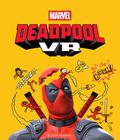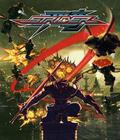Strider's arcade debut in 1989 introduced the world to a stripped-down taste of the manga, which told the story of the Strider organization and its youngest member, Strider Hiryu, as ninja-like assassins wielding hi-tech tools of the trade. Kazakh City, where the initial action took place, was dressed up in scraps of Soviet-like power led by a self-styled emperor as a product of the Cold War, which was still on everyone's mind.
Twenty-five years later, the new Strider is a retelling of the first game, but in this case, it's as if the Double Helix team decided to celebrate the series' entire history in one game. It plays a lot like Strider 2, has elements from its predecessor, and works it all against an open world that's ripe for adventure and storytelling.
Double Helix dove right into the Strider mythos by writing up collectible "enemy intel" and "story" elements that can be discovered through meticulous exploration. Additionally, the comic book-styled monologues by the villains bolster the lightweight narrative. There's enough nostalgia here for fans to crunch through while dramatically expanding it for a new generation that may never have tried the originals.
Like the arcade original, Strider tells the tale of Strider Hiryu, who is sent to Kazakh City with one mission: assassinate Grandmaster Meio, its mysterious leader. Between him and his prey is an army of robot soldiers; Meio's lieutenants; and a labyrinth of locked rooms, underground passages, secret laboratories, and deadly traps.
Strider's claim to action fame is the idea of a lone ninja-like agent attacking heavily armed enemies and terrifying bosses, using little more than his Cypher blade, jumping skills and climbing ability. Stealth isn't even an option; Hiryu doesn't need to sneak around when he can surgically dispatch his foes. Flying PNUT drones, giant robots, machine gunners, missiles and snipers are all weeds to be cut down by Hiryu's blade as he tears through everything.
Additional toys that made temporary cameos in the original game, such as the Terapodal Robo-panther (a glowing, blue energy panther), are eventually added to Hiryu's arsenal, though they aren't quite as useful as his trusty Cypher. On the other hand, kunai throwing blades gave Hiryu an extremely potent ranged attack with upgrades. An energy gauge keeps all of these extras in check, and like his health bar, can be permanently upgraded.
Like the distinctly 2-D action of the game, Strider's signature weapon is still the core of who Hiryu is, and despite the far-reaching changes made to the gameplay, it remains his most important weapon. It also doubles as the key to progress in later areas and gives the player an excuse to backtrack to rooms that they might not have been able to reach previously.
Cypher enhancements include being able to freeze enemies and use them as cover and a magnetic power that shoots homing energy boomerangs. Hiryu's kunai can also be similarly upgraded into explosive projectiles or freezing enemies on the spot, creating opportunities to get to certain hard-to-reach areas. Other upgrades include a double-jump and an extremely versatile "plasma catapult" that can shoot Hiryu short distances — or through enemies — to open new tactical doors.
Juggling all of these options takes a bit of practice, but the gamepad controls (I used an Xbox 360 controller) made ripping through Meio's cyber forces a satisfying jaunt. If you don't have one, it's also playable using the keyboard, though it's clear this game was designed for some kind of gamepad.
Later, more challenging, enemies require increased acrobatic finesse, but Double Helix's expansion of Strider's basic combat system turned many combat situations into opportunities to come off as a godlike techno ninja. I was having a blast in switching to a magnetic charge for Hiryu's Cypher, catapulting through enemies to stun them, and then cleaning up by switching to the explosive setting. Did I mention there's an upgrade that enables Cypher to deflect bullets?
All this is set against a variety of great set pieces that add 3-D depth to Strider's 2-D action, which can make some levels look a little confusing until you realize that Hiryu, as a sci-fi super ninja, doesn't need to use stairs or that bridge in the background. Strider is also packed with a lot of verticals and breakable vents to slide through, hinting at hidden places on the map that might provide new routes, extra boosts, or healing items to keep Hiryu in the game. The camera even zooms in or out at certain points, depending on the scene.
As awesome as the game is, Strider does have some nicks along the edge. Old-school weirdness, such as touching a stationary trap platform's surface and then being flung away as if it had hit you, wonky touch detection for electrified panels, and one instance where I catapulted into a location I wasn't supposed to be (a restart from the last checkpoint made everything OK) marred the finish on this production. The first hour or so was also a slow boil. It takes some time to reach the spot where the game begins to shine.
The bosses in the original arcade Strider or its arcade sequel weren't necessarily difficult to beat, and the same holds true for Double Helix's remake. Two or three boss fights, most fittingly the one with the Grandmaster, were rough, leaving the rest lacking in the challenge department as long as you knew how to dodge and button-mash your Cypher at hyperspeed. This made me wonder if I should've selected the Hard difficulty at the outset.
Most of the danger lies in the environment and the enemy combos it tosses at Hiryu. While none of the arcade Strider games were big on traps, this one is, and it can hit as hard as a few of Ninja Gaiden's moments on the NES, when it combines tricky jumps with enemies that can knock you off with missiles, shock you, freeze you from behind a shield, or lay down napalm. There's a narrow "invincibility phasing" window for getting hit, though you sometimes can't avoid being juggled for a few precious seconds. It can seem like a cakewalk for the first few hours until you get closer to your final battle and the environment and enemies start working harder to ruin your run.
Checkpoint-wise, the game can also be brutally old-school, which adds more of a challenge, especially if I had found a bunch of hidden unlockables and then died before returning to a checkpoint-healing station. There are also soft checkpoints scattered outside those stations, such as with boss fights, which alleviate some of the backtracking. However, it would've been nice if this game didn't make the player wait through another boss dialogue scene when returning from defeat.
Finishing the game took a little over seven hours, but I love exploring, so your mileage may vary depending on how many extras you want to find. In addition to art, bios, and story background, other extras include additional stages for beacon races and battle challenges. Beacon races are just that: races to hit beacons and land on the online leaderboard. Battle challenges set a few conditions on what Hiryu can carry into the fight, such as plasma types for his Cypher and health, but they're essentially Strider's version of survival against waves of enemies. If you need a break from the main campaign, both provide plenty. This is also a game that begs to have a boss rush mode.
At the end, it offers to save your stats (there's only one save slot) before starting a new game. If you decide not to save, it puts you back right before embarking on the final battle, so you'll have the opportunity to snag any collectibles that you might have missed. There isn't a new game plus mode, and that could disappoint some fans, but this game doesn't really need it. If you want to revisit previous areas with your new weapons, there's nothing that's stopping you once you have access to them.
It's been 14 years since the last Strider game, and that was a sequel to the 1989 arcade classic. Hiryu hasn't had many games to his name, either, sometimes popping up in a fighting game such as 1998's Marvel vs. Capcom: Clash of Super Heroes. No Strider fan should be without Double Helix's take on the title. It's not perfect, and the chrome finish is marred by a few pacing and polish quibbles, but successfully taking Hiryu's seemingly anachronistic style into the 21st century has only proven how much he has improved with time.
Score: 8.6/10
More articles about Strider










 The original assassin returns in an all-new intense side-scrolling action platformer.
The original assassin returns in an all-new intense side-scrolling action platformer.








































